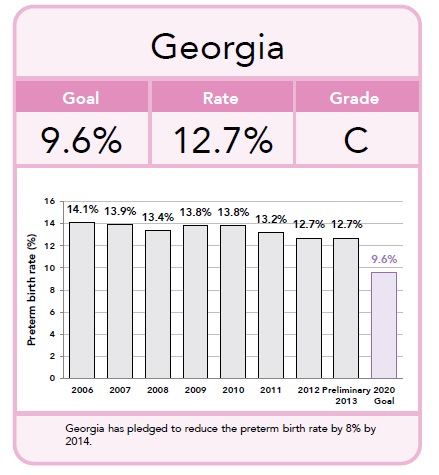Georgia’s preterm birth rate remained steady in 2013 at 12.7 percent, earning the state a “C’’ grade on an annual March of Dimes report card released Thursday.
The data, though, show Georgia’s premature birth generally declining since 2006, when the percentage hit 14.1 percent.
The national preterm birth rate, meanwhile, fell to 11.7 percent in 2013, the lowest in 17 years, the March of Dimes said.
Preterm births — those before 37 completed weeks of pregnancy — cost the U.S. more than $26 billion annually, according to the Institute of Medicine. And preterm birth is the leading cause of newborn death.
Babies who survive an early birth often face the risk of lifelong medical challenges, such as breathing problems and cerebral palsy. Even babies born just a few weeks early have higher rates of hospitalization and illness than full-term infants.
The report card shows Georgia did well in reducing late preterm births, and the percentage of Georgia women who smoke also has dropped. Smoking by the mother is a risk factor for early births.
Yet one problem area has become worse: Insurance coverage for women in the state.
The report card shows that the percentage of uninsured women in Georgia rose to 26.1 percent from 25.8 percent.
“We would like all mothers-to-be to be insured,’’ Sheila Ryan, state director of the March of Dimes, told GHN on Thursday. Women with health insurance, she said, “are going to be more likely to get the care they need all through their pregnancy.”
The March of Dimes supports increasing insurance coverage, including through Medicaid expansion, she said. Georgia’s political leadership has opted to oppose that expansion, citing costs to the state.
South’s performance poor overall
The report card figures reflect 2013 preliminary data from the National Center for Health Statistics.
Three Southern states – Louisiana, Mississippi and Alabama – received an “F’’ grade on the report card, while Florida and South Carolina got a “D.” Only one Southern state, Virginia, earned a “B.”
Georgia has pursued several successful strategies on preterm births, Ryan said.
She said Georgia has reduced early elective deliveries, which are medically unnecessary inductions and C-sections scheduled before 39 weeks of pregnancy.
The March of Dimes said regions in Georgia that had traditionally reported poor outcomes data for maternal and infant health factors have adopted programs to address preterm births.
The Savannah, Valdosta and Dublin areas have started home visitation programs to provide additional support to high-risk mothers. Communities such as Albany, Atlanta, Athens and Augusta have implemented the “centering pregnancy” model to provide health assessments, education and group support for women, the March of Dimes said.
Challenges ahead
Dr. Brenda Fitzgerald, commissioner of the Georgia Department of Public Health, applauded the general decline in preterm births.
“Our success is a testament to the hard work of Georgia’s state and local health departments, our hospital partners and health care providers,’’ Fitzgerald said in a statement. “It shows that when a health problem as complex as preterm birth is challenged with strong policies and bold leadership, babies — and their moms — benefit.”
Still, there are challenges out there. Dozens of counties in Georgia have no obstetrical services, and many others have an OB deficit, according to Public Health.
Merrilee Gober of Healthy Mothers, Healthy Babies Coalition of Georgia said lack of health insurance and gaps in obstetrical care in rural areas contribute to the fact that in 2012, 1,797 pregnant women in the state delivered babies without having had any prenatal care.
On Nov. 17, the March of Dimes and organizations from around the world will mark the fourth World Prematurity Day. Learn more by visiting http://www.facebook.com/worldprematurityday


